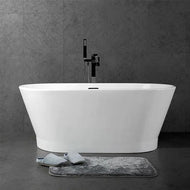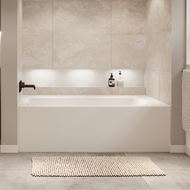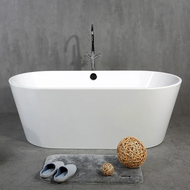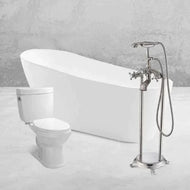Collection: Bathtubs
Shop by Cabinet Type
Wattage
Color Temperature
Size
Color
Mounting
Features
Wattage Replacement
Lumens
Approvals / Ratings
Arm Support
Type
Back Type
Material
Shape
Direction
Pieces Include
Style
Thickness
Collections
Bulb Color
Wire Color
Seat
Light Color
Bulb Type
Finish
Cooling Capacity
Ton
Shade
Temperature Range
Liter
Door Type
Drawer Type
Input Voltage
Shop By Cabinet Sub-Category
Door Width
Door Height
Texture Name
Handle Material
Edge Type
Water Protection
Drain Placement
Installation
Faucet Hole
Wear layer
Collection: Bathtubs
About Bathtubs
After a long and hectic day at the office or staying home all day with the kids, the bathtub is a great place to relax and unwind. We do not only offer world-class bathtubs for purchase but also provide guidance on how to find the perfect tub that matches your personal tastes and needs.
What Are The Different Types of Bathtubs?
The first question that comes to mind when planning to buy a bathtub is which type of bathtub to buy.
Bathtubs can be broadly categorized into the following types:
Standard Bathtubs
Standard tubs are the most common type of tub among bathtubs. The most affordable option available which usually has the following standard dimensions: 60 inches in length, 30 to 32 inches in width, and 14 to 16 inches in depth.
Soaking Bathtubs
Soaking tubs are different from a standard tub. They provide extra depth for an authentic and relaxing soaking experience. Soaking tubs are available in various lengths, widths, and depths so that people of all body shapes and sizes can soak in them comfortably.
Whirlpool Bathtubs
Water jets are positioned near the major muscle groups in the Whirlpool tubs to provide a soothing and relaxing massage experience. They are a good fit for people who suffer from joint pain and muscle soreness, as water jets are a great way to reduce aches and pains.
Air Bathtubs
Similar to whirlpool tubs except they use air jets as opposed to water jets. The air jets propel air from several different ports that spread the pressure out, unlike the concentrated water jets in a whirlpool tub. The sensation of an air bathtub is less intense and some find it more relaxing than a whirlpool tub.
Combination Bathtubs
Combination tubs are multifunctional soaking tubs that offer the comfort of both air and whirlpool technologies and are comparatively more expensive.
What Are the Benefits of Different Bathtub Materials?
Acrylic - Lightweight with molded construction and simpler to clean because of its non-porous surface.
Copper -Appealing design with resistance to scratches and chips, although difficult to find.
Cast Iron - The enamel, which is usually porcelain or ceramic, is tough and can withstand most bathtub wear and tear. They retain heat, though a little heavier than the alternatives.
Solid Surface - Resin or stone composite tubs, often made to look like stone, are long-lasting and non-porous. They retain heat well, are simpler to clean, and have little to no color loss over time.
How To Choose The Right Drain Placement?
The drain placement of a tub refers to where the drain and overflow holes lead to within the tub's body. While a new soaking tub will most likely meet the same standard plumbing requirements as your old tub, the drain holes must be prefabricated in the tub to match up, so this isn't something a plumber can change.
Look at your tub from the front, open side, that faces the middle of the room to figure out where the drain should go. A center drain is available in some tubs, which makes things a little easier. If your drain is on the left, you'll need a left drain placement tub, and if your drain is on the right, you'll need a right drain placement tub.
The drain is situated at one end of the tub with reversible drain placement, and there are no distinguishing elements that define the tub body as having a front or back, allowing the tub to be adjusted to match the plumbing as needed.
FAQs
How much safer are walk-in tubs?
Walk-in bathtubs generally offer an array of safety features that are designed to minimize the chances of falling while taking a bath. The ADA-compliant design features include built-in handrails, anti-slip floors, contoured built-in seating, and low-height steps for entry. Another safety feature called a scald prevention valve prevents dangerously hot water from entering the tub, and some models even include wide doors that allow wheelchair-bound bathers to transfer easily to the tub seat.
What is the standard size for a soaking tub?
Typically, soaking tubs range in length between 60 and 72 inches with some even extending as much as 90 inches in length. And 76 inches in width, which is large enough to fit two bathers side by side. An average-sized soaking tub can hold around 250 gallons of water and offer a depth of at least 14 to 23 inches or even more.
What is the difference between a soaking tub and a standard tub?
A soaking tub is deeper than a standard bathtub because it is designed to allow you to fully submerge. The depth of a standard tub is typically 14 to 16 inches (sometimes as much as 18 or 19 inches), while a soaking tub's average height is 23 inches. As a result, they can hold a lot more water than a standard bathtub.
When it comes to length, soaking tubs have a lot more variety and can be as long as 90 inches compared to just 60 inches for standard tubs.
Which is better, cast iron or acrylic?
Acrylic bathtubs are made from acrylic sheets reinforced with fiberglass, and this makes them resistant to cracks and chips. Scratches typically aren't visible, and damage to acrylic tubs is easily repaired with some acrylic filler that can then be sanded until smooth. Cast iron bathtubs, on the other hand, are made by coating a cast iron bathtub with enamel, and they are very durable and resistant to chemicals, scratches, and dents.
The major disadvantage of cast iron bathtubs is the weight. Not only are they much heavier than acrylic bathtubs, they sometimes even require the floor underneath to be reinforced prior to placement.
If you have got any queries regarding bathtubs, bathroom faucets, bathroom cabinets & vanities, or vanity mirrors, just post them in the question/answer section and we'll get back to you as soon as possible.


 LED High Bay
LED High Bay  LED Tubes
LED Tubes  Smart Ceiling Fans
Smart Ceiling Fans  LED Integrated Tubes
LED Integrated Tubes  LED Light Bulbs
LED Light Bulbs  LED Cooler Tubes
LED Cooler Tubes  LED Panel Lights
LED Panel Lights  LED Downlights
LED Downlights  LED Troffer Lights
LED Troffer Lights  LED Flush Mount Fixtures
LED Flush Mount Fixtures  LED Vanity Mirrors
LED Vanity Mirrors  LED Exit Sign /Emergency Lights
LED Exit Sign /Emergency Lights  LED Under Cabinet Lights
LED Under Cabinet Lights  LED Strip Lights
LED Strip Lights  Chandeliers & Pendant Lights
Chandeliers & Pendant Lights  LED Wall Sconces
LED Wall Sconces  Semi Flush Mount Lights
Semi Flush Mount Lights  Ceiling Lights
Ceiling Lights  Table Lamp
Table Lamp  Floor Lamp
Floor Lamp  Ceiling Lamps
Ceiling Lamps  Bathroom Lighting
Bathroom Lighting  LED Neon Flex lights
LED Neon Flex lights  LED Work Lights
LED Work Lights  Beautine
Beautine  LED Pole Lights
LED Pole Lights  LED Flood Lights
LED Flood Lights  LED Canopy Lights
LED Canopy Lights  LED Corn Bulbs
LED Corn Bulbs  LED Wall Packs
LED Wall Packs  LED Post Top Light
LED Post Top Light  LED Modules & Sign Bars
LED Modules & Sign Bars  LED Solar Batten Light
LED Solar Batten Light  Outdoor Wall Sconce
Outdoor Wall Sconce  Bollard Lights
Bollard Lights  LED Solar Wall Packs
LED Solar Wall Packs  Outdoor Wall Lighting
Outdoor Wall Lighting  Outdoor Step Lights
Outdoor Step Lights  LED Up and Down Light
LED Up and Down Light  Wall Pack Lights
Wall Pack Lights  LED Tube Light
LED Tube Light  Cables & Extensions
Cables & Extensions  Mounting Accessories
Mounting Accessories  Sensors & Dimmers
Sensors & Dimmers  LED Strip Light Accessories
LED Strip Light Accessories  Power Pack
Power Pack  Luxury Vinyl Plank Flooring
Luxury Vinyl Plank Flooring  Waterproof Vinyl Flooring
Waterproof Vinyl Flooring  Wood Look Vinyl Flooring
Wood Look Vinyl Flooring  Glue Down Vinyl Plank
Glue Down Vinyl Plank  Waterproof Laminate Flooring
Waterproof Laminate Flooring  COREtec Flooring
COREtec Flooring  Shaw Flooring
Shaw Flooring  Lux Flooring
Lux Flooring  Permshield
Permshield  Flooring Tools
Flooring Tools  Backer Board
Backer Board  Floor Levelers
Floor Levelers  Tile Mortar
Tile Mortar  Tile Grout
Tile Grout  Flooring Adhesive
Flooring Adhesive  Flooring Sealers
Flooring Sealers  Transition Strips
Transition Strips  View All Flooring Supplies
View All Flooring Supplies  Area Rugs
Area Rugs  5' X 7' Area Rugs
5' X 7' Area Rugs  8' X 10' Area Rugs
8' X 10' Area Rugs  8' X 11' Area Rugs
8' X 11' Area Rugs  Rectangle
Rectangle  Outdoor Rugs
Outdoor Rugs  Rug Pads
Rug Pads  Door Mats
Door Mats  Stair Runners
Stair Runners  View All Area Rugs
View All Area Rugs  Anatolia
Anatolia  Castello
Castello  AWP
AWP  Decovita
Decovita  Forest Element
Forest Element  IWT
IWT  MSI
MSI  Panaria Group
Panaria Group  STO
STO  VIK
VIK  Porcelain Tile
Porcelain Tile  Ceramic Tile
Ceramic Tile  Marble Tile
Marble Tile  Glass Tile
Glass Tile  Natural Stone Tile
Natural Stone Tile  Wood Look Tile
Wood Look Tile  Subway Tile
Subway Tile  Marble-Look Tile
Marble-Look Tile  Penny Tile
Penny Tile  Backsplash Tile
Backsplash Tile  Floor Tile
Floor Tile  Wall Tiles
Wall Tiles  Large Format Tile
Large Format Tile  Mosaic Tile
Mosaic Tile  Hexagon Tiles
Hexagon Tiles  Brick Look Tile
Brick Look Tile  Picket Tile
Picket Tile  Tile Edge Trim
Tile Edge Trim  Pull-Down Faucets
Pull-Down Faucets  Pull-Out Faucets
Pull-Out Faucets  1-Handle Standard Faucets
1-Handle Standard Faucets  2-Handle Standard Faucets
2-Handle Standard Faucets  Bar Faucets
Bar Faucets  Bridge Kitchen Faucets
Bridge Kitchen Faucets  Drop-In Sinks
Drop-In Sinks  Undermount Sinks
Undermount Sinks  Farmhouse Sinks
Farmhouse Sinks  Bottom Grid
Bottom Grid  Colander
Colander  Cutlery
Cutlery  Garbage Disposal Flange
Garbage Disposal Flange  Storage Bins
Storage Bins  Soaking Tub
Soaking Tub  Alcove Bath Tubs
Alcove Bath Tubs  Freestanding Bathtubs
Freestanding Bathtubs  Bathtub Combo
Bathtub Combo  Single Sink Bathroom Vanities
Single Sink Bathroom Vanities  Double Sink Bathroom Vanities
Double Sink Bathroom Vanities  Side Cabinets
Side Cabinets  Console Sinks
Console Sinks  Vanity Sink Tops
Vanity Sink Tops  Bathroom Vanities Without Tops
Bathroom Vanities Without Tops  Bathroom Vanities With Tops
Bathroom Vanities With Tops  24 - 26 Inch Vanities
24 - 26 Inch Vanities  High Gloss White
High Gloss White  High Gloss Ash Gray
High Gloss Ash Gray  High Gloss Gray
High Gloss Gray  Black
Black  Rosewood
Rosewood  Natural Oak
Natural Oak  Dark Gray Oak
Dark Gray Oak  New England Oak
New England Oak  White Oak
White Oak  Cement Gray
Cement Gray  Vessel Sinks
Vessel Sinks  Smart Toilets
Smart Toilets  22 Inch Round
22 Inch Round  24x36 Inch
24x36 Inch  36x36 Inch
36x36 Inch  36x48 Inch
36x48 Inch  Shower Panel Systems
Shower Panel Systems  Shower Systems
Shower Systems  Shower & Bathtub Doors
Shower & Bathtub Doors  Shower and Bathtub Wall Surrounds
Shower and Bathtub Wall Surrounds  Shower Base
Shower Base  Shower Seats
Shower Seats  Shower Faucet
Shower Faucet  Shower Heads
Shower Heads  Shower Parts
Shower Parts  Single Hole
Single Hole  Two Hole
Two Hole  Widespread
Widespread  Tub Faucets
Tub Faucets  Tub Filler
Tub Filler  Bath & Shower Grab Bars
Bath & Shower Grab Bars  Bath Set
Bath Set  Towel Bars
Towel Bars  Towel Ring
Towel Ring  Towel Hooks
Towel Hooks  Tub Spouts
Tub Spouts  Tub Supply Elbows
Tub Supply Elbows  Tub Risers
Tub Risers  Tub Mount Couplers
Tub Mount Couplers  Tub Drains
Tub Drains  Wall Union Extension
Wall Union Extension  Pop-Up Drain
Pop-Up Drain  Bathroom Exhaust
Bathroom Exhaust  Vanity Lights
Vanity Lights  Bathroom Wall Lights
Bathroom Wall Lights 




















